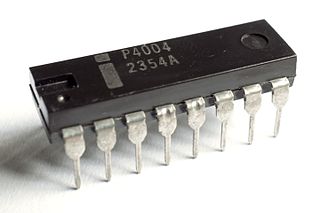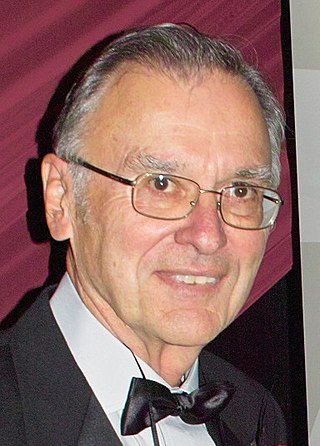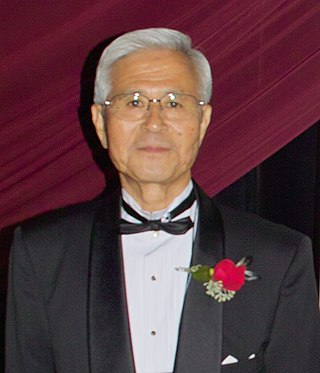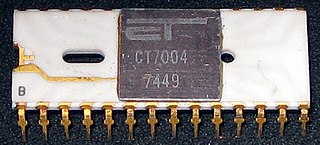Related Research Articles

The Intel 8080 ("eighty-eighty") is the second 8-bit microprocessor designed and manufactured by Intel. It first appeared in April 1974 and is an extended and enhanced variant of the earlier 8008 design, although without binary compatibility. The initial specified clock rate or frequency limit was 2 MHz, with common instructions using 4, 5, 7, 10, or 11 cycles. As a result, the processor is able to execute several hundred thousand instructions per second. Two faster variants, the 8080A-1 and 8080A-2, became available later with clock frequency limits of 3.125 MHz and 2.63 MHz respectively. The 8080 needs two support chips to function in most applications: the i8224 clock generator/driver and the i8228 bus controller. It is implemented in N-type metal–oxide–semiconductor logic (NMOS) using non-saturated enhancement mode transistors as loads thus demanding a +12 V and a −5 V voltage in addition to the main transistor–transistor logic (TTL) compatible +5 V.

A microprocessor is a computer processor for which the data processing logic and control is included on a single integrated circuit (IC), or a small number of ICs. The microprocessor contains the arithmetic, logic, and control circuitry required to perform the functions of a computer's central processing unit (CPU). The IC is capable of interpreting and executing program instructions and performing arithmetic operations. The microprocessor is a multipurpose, clock-driven, register-based, digital integrated circuit that accepts binary data as input, processes it according to instructions stored in its memory, and provides results as output. Microprocessors contain both combinational logic and sequential digital logic, and operate on numbers and symbols represented in the binary number system.

The 6800 is an 8-bit microprocessor designed and first manufactured by Motorola in 1974. The MC6800 microprocessor was part of the M6800 Microcomputer System that also included serial and parallel interface ICs, RAM, ROM and other support chips. A significant design feature was that the M6800 family of ICs required only a single five-volt power supply at a time when most other microprocessors required three voltages. The M6800 Microcomputer System was announced in March 1974 and was in full production by the end of that year.

A microcomputer is a small, relatively inexpensive computer having a central processing unit (CPU) made out of a microprocessor. The computer also includes memory and input/output (I/O) circuitry together mounted on a printed circuit board (PCB). Microcomputers became popular in the 1970s and 1980s with the advent of increasingly powerful microprocessors. The predecessors to these computers, mainframes and minicomputers, were comparatively much larger and more expensive. Many microcomputers are also personal computers. An early use of the term "personal computer" in 1962 predates microprocessor-based designs. (See "Personal Computer: Computers at Companies" reference below). A "microcomputer" used as an embedded control system may have no human-readable input and output devices. "Personal computer" may be used generically or may denote an IBM PC compatible machine.

The Intel 8008 is an early byte-oriented microprocessor designed by Computer Terminal Corporation (CTC), implemented and manufactured by Intel, and introduced in April 1972. It is an 8-bit CPU with an external 14-bit address bus that could address 16 KB of memory. Originally known as the 1201, the chip was commissioned by CTC to implement an instruction set of their design for their Datapoint 2200 programmable terminal. As the chip was delayed and did not meet CTC's performance goals, the 2200 ended up using CTC's own TTL-based CPU instead. An agreement permitted Intel to market the chip to other customers after Seiko expressed an interest in using it for a calculator.

The Intel 4004 is a 4-bit central processing unit (CPU) released by Intel Corporation in 1971. Sold for US$60, it was the first commercially produced microprocessor, and the first in a long line of Intel CPUs.

The history of computing hardware starting at 1960 is marked by the conversion from vacuum tube to solid-state devices such as transistors and then integrated circuit (IC) chips. Around 1953 to 1959, discrete transistors started being considered sufficiently reliable and economical that they made further vacuum tube computers uncompetitive. Metal–oxide–semiconductor (MOS) large-scale integration (LSI) technology subsequently led to the development of semiconductor memory in the mid-to-late 1960s and then the microprocessor in the early 1970s. This led to primary computer memory moving away from magnetic-core memory devices to solid-state static and dynamic semiconductor memory, which greatly reduced the cost, size, and power consumption of computers. These advances led to the miniaturized personal computer (PC) in the 1970s, starting with home computers and desktop computers, followed by laptops and then mobile computers over the next several decades.

The Datapoint 2200 was a mass-produced programmable terminal usable as a computer, designed by Computer Terminal Corporation (CTC) founders Phil Ray and Gus Roche and announced by CTC in June 1970. It was initially presented by CTC as a versatile and cost-efficient terminal for connecting to a wide variety of mainframes by loading various terminal emulations from tape rather than being hardwired as most contemporary terminals, including their earlier Datapoint 3300. However, Dave Gust, a CTC salesman, realized that the 2200 could meet Pillsbury Foods's need for a small computer in the field, after which the 2200 was marketed as a stand-alone computer. Its industrial designer John "Jack" Frassanito has later claimed that Ray and Roche always intended the Datapoint 2200 to be a full-blown personal computer, but that they chose to keep quiet about this so as not to concern investors and others. Also significant is the fact that the terminal's multi-chip CPU (processor)'s instruction set became the basis of the Intel 8008 instruction set, which inspired the Intel 8080 instruction set and the x86 instruction set used in the processors for the original IBM PC and its descendants.

Marcian Edward "Ted" Hoff Jr. is one of the inventors of the microprocessor.

Federico Faggin is an Italian physicist, engineer, inventor and entrepreneur. He is best known for designing the first commercial microprocessor, the Intel 4004. He led the 4004 (MCS-4) project and the design group during the first five years of Intel's microprocessor effort. Faggin also created, while working at Fairchild Semiconductor in 1968, the self-aligned MOS (metal-oxide-semiconductor) silicon-gate technology (SGT), which made possible MOS semiconductor memory chips, CCD image sensors, and the microprocessor. After the 4004, he led development of the Intel 8008 and 8080, using his SGT methodology for random logic chip design, which was essential to the creation of early Intel microprocessors. He was co-founder and CEO of Zilog, the first company solely dedicated to microprocessors, and led the development of the Zilog Z80 and Z8 processors. He was later the co-founder and CEO of Cygnet Technologies, and then Synaptics.

Masatoshi Shima is a Japanese electronics engineer. He was one of the architects of the world's first microprocessor, the Intel 4004. In 1968, Shima worked for Busicom in Japan, and did the logic design for a specialized CPU to be translated into three-chip custom chips. In 1969, he worked with Intel's Ted Hoff and Stanley Mazor to reduce the three-chip Busicom proposal into a one-chip architecture. In 1970, that architecture was transformed into a silicon chip, the Intel 4004, by Federico Faggin, with Shima's assistance in logic design.
4-bit computing is the use of computer architectures in which integers and other data units are 4 bits wide. 4-bit central processing unit (CPU) and arithmetic logic unit (ALU) architectures are those that are based on registers or data buses of that size. A group of four bits is also called a nibble and has 24 = 16 possible values.
The F-14's Central Air Data Computer, also abbreviated as CADC, computes altitude, vertical speed, air speed, and mach number from sensor inputs such as pitot and static pressure and temperature. Earlier air data computer systems were electromechanical computers, such as in the F-111. From 1968 to 1970, the first CADC to use custom digital integrated circuits was developed for the F-14.

Busicom Co., Ltd. was a Japanese company that manufactured and sold computer-related products headquartered in Taito, Tokyo. It owned the rights to Intel's first microprocessor, the Intel 4004, which they created in partnership with Intel in 1970.
The transistor count is the number of transistors in an electronic device. It is the most common measure of integrated circuit complexity. The rate at which MOS transistor counts have increased generally follows Moore's law, which observes that transistor count doubles approximately every two years. However, being directly proportional to the area of a chip, transistor count does not represent how advanced the corresponding manufacturing technology is: a better indication of this is transistor density.

A microprocessor development board is a printed circuit board containing a microprocessor and the minimal support logic needed for an electronic engineer or any person who wants to become acquainted with the microprocessor on the board and to learn to program it. It also served users of the microprocessor as a method to prototype applications in products.

The history of general-purpose CPUs is a continuation of the earlier history of computing hardware.

PMOS or pMOS logic is a family of digital circuits based on p-channel, enhancement mode metal–oxide–semiconductor field-effect transistors (MOSFETs). In the late 1960s and early 1970s, PMOS logic was the dominant semiconductor technology for large-scale integrated circuits before being superseded by NMOS and CMOS devices.

The Intellec computers were a series of early microcomputers Intel produced in the 1970s as a development platform for their processors. The Intellec computers were among the first microcomputers ever sold, predating the Altair 8800 by at least two years.
References
- ↑ Holt, Ray (Aug 27, 2022). The Accidental Engineer (2nd ed.). Lulu.com. pp. back cover. ISBN 978-1471078958.
- 1 2 3 4 5 Sarah Fallon (December 23, 2020). "The Secret History of the First Microprocessor, the F-14, and Me". Wired. ISSN 1059-1028 . Retrieved 2020-12-23.
- ↑ "Ray Holt and the Origins of the Microchip Computer". theaccidentalengineer.com. Apr 17, 2018. Retrieved 2020-12-29.
- ↑ old-computers.com museum
- ↑ "Jolt: OLD-COMPUTERS.COM : The Museum". www.old-computers.com. Retrieved 2020-12-29.
- ↑ "SYM1: OLD-COMPUTERS.COM : The Museum". www.old-computers.com. Retrieved 2020-12-29.
- ↑ "Robart I". Archived from the original on 2015-09-05. Retrieved 2015-08-06.
- ↑ "Robart II". Archived from the original on 2015-09-05. Retrieved 2015-08-06.
- ↑ "Mississippi Robotics website" . Retrieved 2020-12-23.